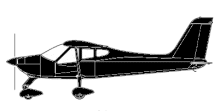
ASN Wikibase Occurrence # 298158
This information is added by users of ASN. Neither ASN nor the Flight Safety Foundation are responsible for the completeness or correctness of this information.
If you feel this information is incomplete or incorrect, you can submit corrected information.
| Date: | Saturday 15 July 2017 |
| Time: | 15:15 LT |
| Type: |  Tecnam P92 Eaglet |
| Owner/operator: | Chesapeake Sport Pilot |
| Registration: | N561TU |
| MSN: | 1561 |
| Year of manufacture: | 2017 |
| Total airframe hrs: | 13 hours |
| Engine model: | Rotax 912 ULS2-01 |
| Fatalities: | Fatalities: 0 / Occupants: 2 |
| Aircraft damage: | Substantial |
| Category: | Accident |
| Location: | Stevensville, Maryland -
 United States of America United States of America
|
| Phase: | Approach |
| Nature: | Private |
| Departure airport: | STEWARTSTOWN, PA (0P2) |
| Stevensville, MD (W29) | |
| Investigating agency: | NTSB |
| Confidence Rating: |
While in the airport traffic pattern for landing at the conclusion of a cross-country flight, the airplane experienced a total loss of engine power, and the pilot performed a forced landing during which the airplane sustained substantial damage. The airplane had recently been purchased and the Rotax 912 ULS engine had 13.2 hours total operating time. Review of onboard data indicated that the fuel pressure, cylinder head temperature, and oil temperature remained relatively steady until the loss of power occurred, which indicated that the engine failure likely did not involve the fuel system, cooling system, or lubrication system. Examination of the engine revealed that there was no oil in the oil line between the oil thermostat and oil pump. The oil pump drive pin also displayed excessive wear in relation to the operating hours of the engine, and the magnetic plug was covered in metallic particles, although the oil filter was clean.
Further examination of the engine revealed that the No. 1 cylinder was substantially damaged, and evidence of bluing was present. The cylinder's exhaust valve spring retainer was fractured in half, and one half of the cotter was fractured. A small ridge could be felt on the exhaust valve spring retainer and galling (a rough surface) was visible on the exhaust valve bore in the cylinder head. The hydraulic lifter for the exhaust valve displayed a small indentation on the edge of the lifter, and when the hydraulic lifters were manually depressed, the lifter for the exhaust valve was easier to depress than the lifter for the intake valve. The pushrod for the exhaust valve was straight, but displayed a ridge on the rocker arm side of the pushrod, and the rocker arm displayed impact damage on the valve connection face. The exhaust valve was found in the combustion chamber. It was chipped, and bent, and deformed into an 'S†shape. A hole was visible in the piston as the result of the piston face striking the exhaust valve after it dropped into the cylinder.
A small amount of oil captured from the hydraulic tappets indicated that the oil contained significantly elevated levels of nickel, which could have come from manganese-containing alloys, as they occur in high-alloy hardened steels, e.g. for camshafts, valves or valve shafts.
Examination of the fractured surface on the exhaust valve spring retainer revealed the presence of fatigue with pronounced vibration stripes when viewed with an electron microscope; however, the heat treatment corresponded to the target specifications, as did the statistical process control value, and the root cause of the failure could not be determined based on the available information.
Probable Cause: The failure of an exhaust valve spring retainer due to metal fatigue for reasons that could not be determined, which resulted in a total loss of engine power.
Accident investigation:
 |
|
Sources:
NTSB ERA17LA246
Location
Revision history:
| Date/time | Contributor | Updates |
|---|---|---|
| 15-Oct-2022 13:49 | ASN Update Bot | Added |
Corrections or additions? ... Edit this accident description
The Aviation Safety Network is an exclusive service provided by:


 ©2024 Flight Safety Foundation
©2024 Flight Safety Foundation